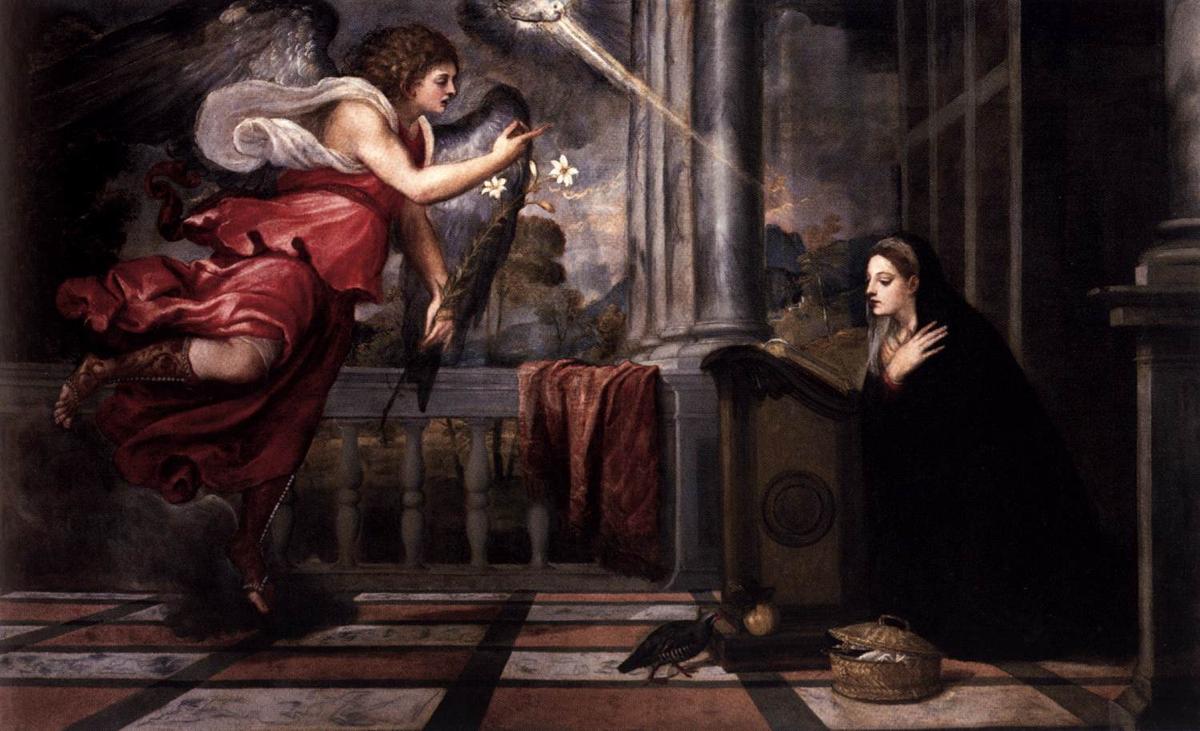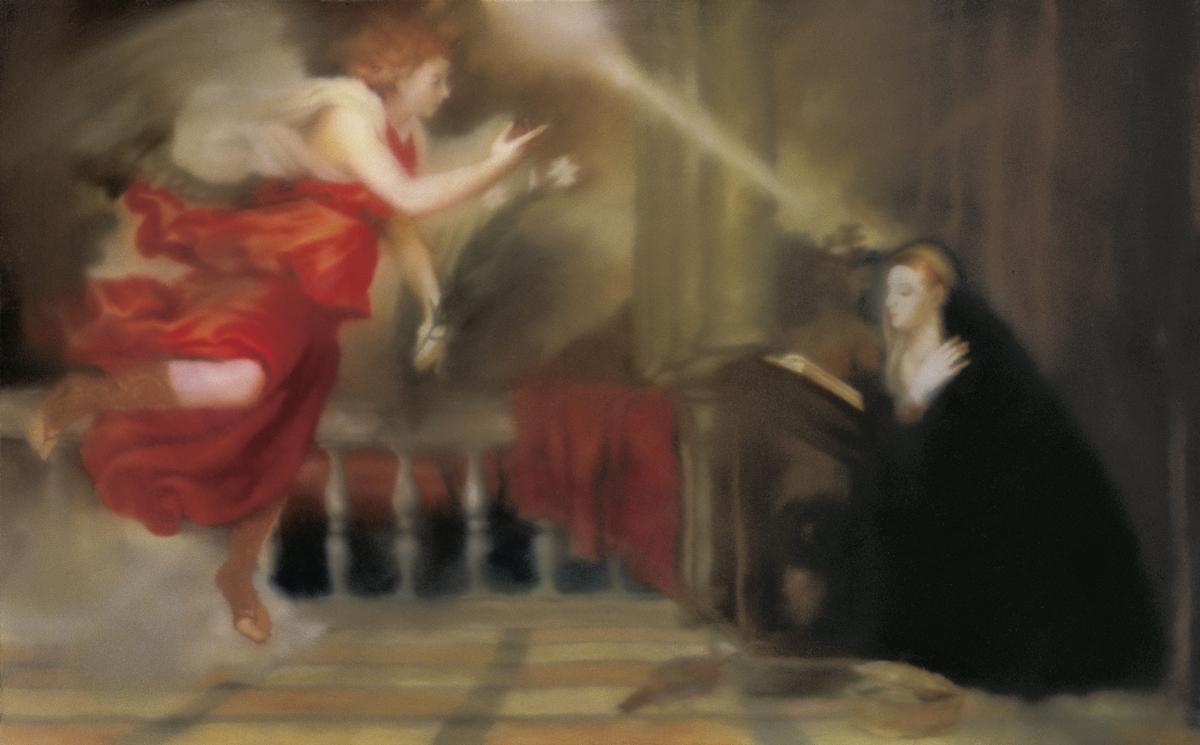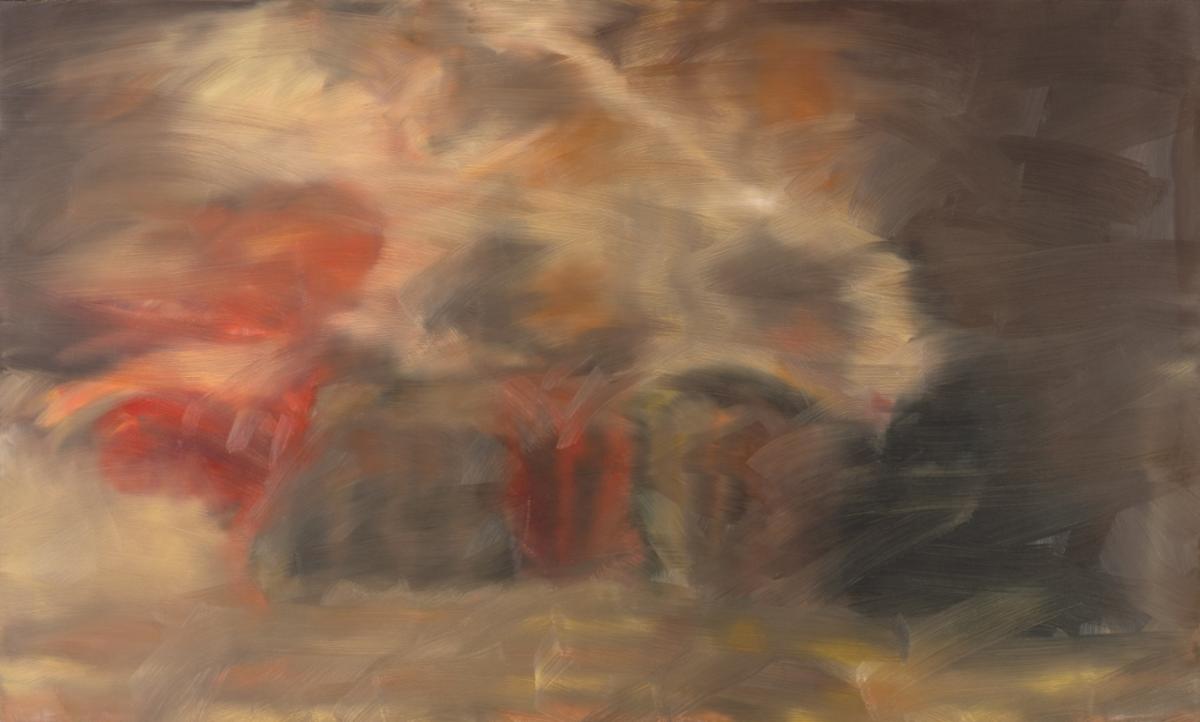December 13: Nothing is Impossible with God
♫ Music:
Mary’s Conversation with Gabriel
Scripture: Luke 1: 34-38
And Mary said to the angel, “How will this be, since I am a virgin?” And the angel answered her, “The Holy Spirit will come upon you, and the power of the Most High will overshadow you; therefore the child to be born will be called holy—the Son of God. And behold, your relative Elizabeth in her old age has also conceived a son, and this is the sixth month with her who was called barren. For nothing will be impossible with God.” And Mary said, “Behold, I am the servant of the Lord; let it be to me according to your word.” And the angel departed from her.
Annunciation
by Sietze Buning
“Be it done to me according to your word,”
she tells the angel with a curtsy.
Well brought up, she knows her place,
knows what to say to her betters.
Well brought up, she does not wonder aloud
but wonders silently about the Refiner’s Fire
and how she will abide the day of his coming
and how will she stand when he appears?
Well brought up,
she bothers nobody. Alone
she waits for the apocalypse
of birth.
NOTHING IS IMPOSSIBLE WITH GOD
One never knows when some holy invitation might present itself. It might tiptoe quietly, circuitously, through some crack in the door, or come subtly hidden in an innocuous conversation. Some invitations must be delivered by angels, and these seem to generally come when one least suspects them. Mary was living a quiet life in a small town. Probably it was not like the graceful imaginings of a Venetian painter, no dramatic lighting, opulent surroundings, or elegant poses. Though all of these make for great art, the actual exchange was likely halting, awkward, frightening, disorienting. Mary was probably not much older than my 13 ½ year old daughter, and this very real angel appeared, speaking in some tongue Mary readily understood, and Mary somehow found the courage to speak.
How…?
Mary’s question reminds us of the reality of her historical situation. Before the angel had spoken to Zechariah, and her prophet cousin had been conceived, the children of Israel had lived in a prolonged and bitter silence. And now, this impossible announcement comes to a teenage girl. Mary’s incredulity is understandable, and her question, while broadly theological, is also intensely personal.
…since I am a virgin.
Miraculous pregnancies, like Sarah’s and Elizabeth’s, were part of the history of God’s work, but never had one been born to a virgin. There are fundamental bodily stakes here for this young woman. She is about to become pregnant, not fairy tale pregnant, but swollen, nauseated, food-craving pregnant. She might rightfully want to know how this is going to happen. Mary’s body is about to become part of the divine plan, and it will also become the subject of gossip, religious judgment, and even conflict. It will also become the place where God will be nourished and will grow. In receiving this invitation, Mary gives up her life, losing it for the sake of Christ.
Nothing will be impossible with God.
This most beautiful statement is given to Mary at the beginning of her journey, and I wonder how many times in her journey with Christ she might have returned to these words. Mary would have known so little about what her response would truly mean for her life, and for all human life.
Let it be...
As Mary responds to this invitation, something will be and will become through her and in her. It is this invitation to have Christ be in and through us to which we all must respond, and we must all do so while knowing very little of what will come after, and what impossibilities it might hold.
The three versions of Gerhard Richter’s Annunciation, after Titian, are among other things a meditation on such partial knowing and mediated seeing. Painters have long been obsessed with the Annunciation as a subject, because Mary’s seeing, hearing and responding to the angel is echoed in how paintings work. They offer lesser holy visions, images that speak, and bid both painter and viewer to receive their subtle and complex invitations. Richter approaches Titian’s painting to put its representation of this great subject to the test, obscuring it into the liquid material of paint. There is a natural inclination to read these images moving from the recognizable image toward the abstraction. But I encourage you, as you spend time with these paintings today, not to see them in any particular order, allow Titian’s image to coalesce again after its dissolution. This image of Mary and the Angel is eidetic, always resurfacing.
The space of unknowing, of not seeing, is the space in which faith must emerge. Perhaps it does not matter much if one sees an angel, a blinding light, a blur of paint, or if one simply hears good news delivered softly, circuitously, by someone familiar. The response is to such as you have been given is always the first step in real becoming.
Prayer
Father, I receive your invitation.
Abide in me.
Inhabit my body, become yourself in some new way.
Even without seeing, without knowing,
I say yes to the sword, which pierces my spirit,
Even as I am called “Blessed.”
Amen.
Jonathan Puls
Interim Dean of SAS, Fine Arts and Communications
Associate Professor of Art History and Painting
Annunciation
Titian
Oil on canvas
Church of San Salvador, Venice, Italy
Annunciation (after Titian) in 3 states
Gerhard Richter
Oil on canvas
Hirshhorn Museum and Sculpture Garden, Washington, D.C.
About the Artists and Art:
Gerhard Richter (b. 1932) is a German painter who originally trained in a realist style and later developed an appreciation for the more progressive work of his American and European contemporaries. Richter increasingly employed his own painting as a means for exploring how images that appear to capture "truth" often prove, on extended viewing, far less objective, or unsure in meaning, than originally assumed. Other common themes in his work are the elements of chance, and the play between realism and abstraction. Working alongside but never fully embracing a quick succession of late twentieth century art movements, such as Abstract Expressionism, American/British Pop art, Minimalism, and Conceptualism, Richter has absorbed many of their ideas while remaining skeptical of all grand artistic and philosophical credos.
After seeing Titian’s Annunciation in Venice, Gerhardt Richter painted a copy, working from a postcard. He made the copy “so that I could have a beautiful painting at home and with it a piece of that period, all that potential beauty and sublimity.” However after finishing one copy, Richter made four additional copies. In the later copies, Richter transforms Titian’s Annunciation to the point that we might not immediately recognize it. Departing from the formal realism of Titian’s Annunciation, Richter’s subsequent treatment of the image reveals a multifaceted strategy which distills Titian’s work into an abstract encounter of light, form, color, and substance, vividly capturing the supernatural moment of conception.
https://www.gerhard-richter.com
About the Music:
“Come Down O Love Divine”
Lyrics:
Come down, O love divine, seek Thou this soul of mine,
And visit it with Thine own ardor glowing.
O Comforter, draw near, within my heart appear,
And kindle it, Thy holy flame bestowing.
O let it freely burn, til earthly passions turn
To dust and ashes in its heat consuming;
And let Thy glorious light shine ever on my sight,
And clothe me round, the while my path illuming.
Let holy charity mine outward vesture be,
And lowliness become mine inner clothing;
True lowliness of heart, which takes the humbler part,
And o'er its own shortcomings weeps with loathing.
And so the yearning strong, with which the soul will long,
Shall far out-pass the power of human telling;
For none can guess its grace, till he become the place
Wherein the Holy Spirit makes His dwelling.
About the Composer/Performer:
Fernando Ortega (b. 1957) is an evangelical Christian singer-songwriter and worship leader, heavily influenced by traditional hymns as well as his family’s heritage in Albuquerque, New Mexico. Much of his current inspiration comes from the North American Anglican liturgy. From the late-70s to the mid-90s, he served in music ministry at a number of churches in New Mexico and Southern California. From 1993 to the present, Ortega has worked as a concert and recording artist, and has released 14 albums.
www.fernandoortega.com
About the Poet:
Dr. Stanley Wiersma (1930-1986), who is best known by his pseudonym of Sietze Buning, was a former Calvin College English professor, poet, and author. Perhaps his best writings are Purpaleanie and Style and Class, which are based on auto-biographical experiences growing up in Northwest Iowa. Stan was a Fine Arts Guild faculty mentor for the Visual Arts Guild at Calvin College. Professor Wiersma, was also known for his encouragement to young Christian authors.



